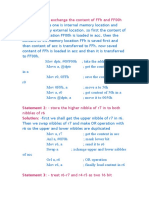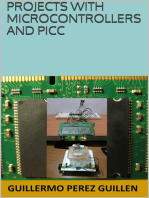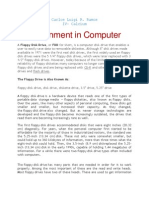ES Unit 3 Solutions: Solution
ES Unit 3 Solutions: Solution
Uploaded by
Niraj UpadhayayaCopyright:
Available Formats
ES Unit 3 Solutions: Solution
ES Unit 3 Solutions: Solution
Uploaded by
Niraj UpadhayayaOriginal Title
Copyright
Available Formats
Share this document
Did you find this document useful?
Is this content inappropriate?
Copyright:
Available Formats
ES Unit 3 Solutions: Solution
ES Unit 3 Solutions: Solution
Uploaded by
Niraj UpadhayayaCopyright:
Available Formats
ES Unit 3 Solutions
Question 1: For 8051 system of 11.0592 MHz, find how long it takes to execute each instruction.(a) MOV R3,#55 (b) DEC R3 (c) DJNZ R2 target (d) LJMP (e) SJMP (f) NOP (g) MUL AB (Solution: Machine cycles (a) 1 (b) 1 (c) 2 (d) 2 (e) 2 (f) 1 (g) 4 Time to execute (a) 1x1.085s = 1.085s (b 1x1.085s = 1.085s (c) 2x1.085s = 2.17s (d) 2x1.085s = 2.17s (e) 2x1.085s = 2.17s (f) 1x1.085s = 1.085s (g) 4x1.085s = 4.34s
Question2 : Write code to send out alternative values of 55H and AAH to port 0. Solution : The following code will continuously send out to port 0 the alternating value 55H and AAH BACK: MOV A,#55H MOV P0,A ACALL DELAY MOV A,#0AAH MOV P0,A ACALL DELAY SJMP BACK
Question 3A: - treat r6-r7 and r4-r5 as two 16 bit registers. Perform subtraction between them. Store the result in 20h (lower byte) and 21h (higher byte). Solution: - first we shall clear the carry. Then subtract the lower bytes afterward then subtract higher bytes. Clr c ; clear carry Mov a, r4 ; get first lower byte Subb a, r6 ; subtract it with other Mov 20h, a ; store the result Mov a, r5 ; get the first higher byte Subb a, r7 ; subtract from other Mov 21h, a ; store the higher byte Question 3B: - divide the content of r0 by r1. Store the result in r2 (answer) and r3 (reminder). Then restore the original content of r0. Solution:-after getting answer to restore original content we have to multiply answer with divider and then add reminder in that. Mov a, r0 ; get the content of r0 and r1 Mov b, r1 ; in register A and B Div ab ; divide A by B Mov r2, a ; store result in r2 Mov r3, b ; and reminder in r3 Mov b, r1 ; again get content of r1 in B Mul ab ; multiply it by answer Add a, r3 ; add reminder in new answer Mov r0, a ; finally restore the content of r0 Question 4A: - transfer the block of data from 20h to 30h to external location 1020h to 1030h. Solution: - here we have to transfer 10 data bytes from internal to external RAM. So first, we need one counter. Then we need two pointers one for source second for destination. Mov r7, #0Ah ; initialize counter by 10d Mov r0, #20h ; get initial source location Mov dptr, #1020h ; get initial destination location Nxt: Mov a, @r0 ; get first content in acc Movx @dptr, a ; move it to external location Inc r0 ; increment source location Inc dptr ; increase destination location
Djnz r7, nxt
; decrease r7. if zero then over otherwise move next
Question 4B: - find out how many equal bytes between two memory blocks 10h to 20h and 20h to 30h. Solution: - here we shall compare each byte one by one from both blocks. Increase the count every time when equal bytes are found Mov r7, #0Ah ; initialize counter by 10d Mov r0, #10h ; get initial location of block1 Mov r1, #20h ; get initial location of block2 Mov r6, #00h ; equal byte counter. Starts from zero Nxt: Mov a, @r0 ; get content of block 1 in acc Mov b, a ; move it to B Mov a, @r1 ; get content of block 2 in acc Cjne a, b, nomatch ; compare both if equal Inc r6 ; increment the counter Nomatch: inc r0 ; otherwise go for second number Inc r1 djnz r7, nxt ; decrease r7. if zero then over otherwise move next Question 5: - given block of 100h to 200h. Find out how many bytes from this block are greater then the number in r2 and less then number in r3. Store the count in r4. Solution: - in this program, we shall take each byte one by one from given block. Now here two limits are given higher limit in r3 and lower limit in r2. So we check first higher limit and then lower limit if the byte is in between these limits then count will be incremented. Mov dptr, #0100h ; get initial location Mov r7, #0FFh ; counter Mov r4, #00h ; number counter Mov 20h, r2 ; get the upper and lower limits in Mov 21h, r3 ; 20h and 21h Nxt: Movx a, @dptr ; get the content in acc Cjne a, 21h, lower ; check the upper limit first Sjmp out ; if number is larger Lower: jnc out ; jump out Cjne a, 20h, limit ; check lower limit Sjmp out ; if number is lower Limit: jc out ; jump out Inc r4 ; if number within limit increment count Out: inc dptr ; get next location
Djnz r7, nxt ; repeat until block completes Question 6:- the crystal frequency is given as 12 MHz. Make a subroutine that will generate delay of exact 1 ms. Use this delay to generate square wave of 50 Hz on pin P2.0 Solution: - 50 Hz means 20 ms. And because of square wave 10 ms ontime and 10 ms offtime. So for 10 ms we shall send 1 to port pin and for another 10 ms send 0 in continuous loop. <_x0021_xml:namespace prefix="st1" ns="urn:schemas-microsoftcom:office:smarttags"/>Loop: Setb p2.0 ; send 1 to port pin Mov r6, #0Ah ; load 10d in r6 Acall delay ; call 1 ms delay 10 = 10 ms Clr p2.0 ; send 0 to port pin Mov r6, #0Ah ; load 10d in r6 Acall delay ; call 1 ms delay 10 = 10 ms Sjmp loop ; continuous loop Delay: ; load count 250d Lp2: Mov r7, #0FAh Lp1: Nop ; 1 cycle Nop ; 1+1=2 cycles Djnz r7, lp1 ; 1+1+2 = 4 cycles Djnz r6, lp2 ; 4250 = 1000 cycles = 1000 s = 1 ms ret Question 7:-count number of interrupts arriving on external interrupt pin INT1. Stop whencounter overflows and disable the interrupt. Give the indication on pinP0.0 Solution: -as we know whenever interrupt occurs the PC jumps to one particular location where its ISR is written. So we have to just write one ISR that will do the job Movr2, #00h ; initialize the counter Movie, #84h ; enable external interrupt 1 Here: Sjmp here ; continuous loop Org 0013h Incr2 Cjner2, #00h, out Movie, #00h Clr p0.0 Out : reti ; interrupt 1location ; increment the count ; check whether it overflows ; if yes then disable interrupt ; and give indication ; otherwise keep counting
Answer 8: Generating Square Wave on the Port
A number is assigned to port 1 which simulates input operation. The port 1 contents are complemented and sent to the port 1. The square wave can be observed on port 1 by using CRO.
Program Source Code
************************************************ #include<reg51.h> void delay(int); void delay(int k) { int i,j; for (j=0;j<k+1;j++){ for (i=0;i<100;i++); }} void main(void) { int N1=0; number. while(1) { N1 =N1; delay(10); P1 = N1; delay (10); } // End of main. ************************************************
Answer 9: Sending Data to the Ports by Assigning Values to a Character
This program illustrates assigning values to the character and then sending it to the port. Here the characters a, b, c are assigned with the Hex numbers and these values are sent to ports.
Program Source Code
*************************************************** #include<REG51.H> void main(void) { { }} char a,b,c; while(1) // Define the characters a, b and c. / Assign 01H to a / / Assign 02H to b / / Assign 03H to c / / Send value assigned to a to port 0/ / Send value assigned to b to port 1/ / Send value assigned to c to port 2/ a=0x01; b=0x02; c=0x03; P0=a; P1=b; P2=c; ***************************************************
Answer 10: Configuring the Ports as Input
By default all the ports act as output port. They can be configures as input by writing FFH to them. The programmer need not bother about the actual SFR address. Thanks to the header file included at the top.
The actual input operation is simulated by assigning values to the variables. The actual DIP switch interfaced as input device is covered further in the text. Program below illustrates the simplest way to define the ports as an input port and how to read the input from the ports and the result is observed in the simulation window.
Program Source Code
********************************************************* #include<REG52.H> void main(void) { { }} char N1,N2,N3; P0=0xFF; P1=0xFF; while(1) // Defining the characters. // set P0 as input // set P1 as input /Input value of P0 in N1/ ;/Input value of P1 in N2/ // Addition of the two inputs /Send value of N3 to port 2/ N1=P0; N2=P1 N3=N1+N2; P2=N3;
Answer 11: Software Delay Loops Combined with I/O Ports
The program demonstrates generation of software delay using two loops operating on a single count. An integer x is declared and assigned a count equal to 10,000. While(1) loop keeps the program in continues loop. The other two loops are conditional with the first loop executes when while(x > 1) is valid, i.e., when x is greater than 1. The other loop executes when x is less than 10,000. Note the usage of decrement () and increment (++) operators. Both these loops are embedded in the main loop. To observe the output of this connect the port 1 to LEDs. The output can also be verified in the simulator window.
Program Source Code
********************************************************* **** #include <reg51.h> void main (void) 44
Importance of Ports
{ int x = 10000; while(1) { while(x > 1) { P1 = 0x0f; x--; } // end of first loop while(x < 10000) { P1 = 0xf0; x++; } // end of second loop. / 10000 count delay / / set leds on PORT1 to 00001111 /
/ decrement x / / 10000 count delay / / set leds on PORT1 to 11110000 / / increment x / } // End of open loop. } // End of main. *********************************************************
Answer 12: Alternate Method of Software Delay Generation with Port Programming
This program illustrates the use of FOR construct for delay generation which toggles only one port pin (P1.1). Note the use of ! operator for complementing the variable.
Program Source Code
********************************************************* #include<reg52.h> sbit vin = P1 0 ; void main(void) { int i; vin = 1; while(1) { for(i=0;i<=3000;i++); for(i=0;i<=3000;i++); vin = !vin; //complement port pin P1.0 after delay } } *********************************************************
Answer 13: Scrolling LED
This program illustrates the interfacing of LED with scrolling pattern. The display appears as if the LED is shifting. The LED connected to the port 0 glows one by one. A software delay is used to define scrolling interval.
Program Source Code
******************************************************* #include <REG52.H> void main(void) { { int i; char N1; while(1) // define the integer number //define the character to assign the hex number N1=0x01; while(N1!=0x00) { // routine for scrolling interval for(i=1;i<10000;i++); } }} P0=N1; N1=N1>>1; // display the LED corresponding to N1 //shift right by one *******************************************************
Answer 14: Exploring Bit Capabilities of the Microcontroller
This program makes use of the microcontrollers bit programming capability. Here the single port pin is used as an output. The program toggles the single port pin to give a continuous on/off pattern on pin P1.1. Input from P1.0 is simulated.
Program Source Code
********************************************************* #include<reg52.h> sbit van= P10; sbit new = P11; void main(void) { / Pin declaration vinod = port 1 pin 0 / / Pin declaration new = port 1 pin 1 / // Define the int vinod / Infinite loop (i.e.,countinuos loop) / / Simulating input from port pin P1.0 and assigning the same to character van / / send output to port1 pin1 / //compliment vinod // end of loop int vinod; vinod = 0x00; while(1) { van = vinod; new = vinod; vinod=!vinod; } } // End of main *********************************************************
You might also like
- Laboratory Report (For Online Lab Class Only) : ECTE333: Microcontroller Architecture and Application Spring 2020 SessionDocument8 pagesLaboratory Report (For Online Lab Class Only) : ECTE333: Microcontroller Architecture and Application Spring 2020 SessionSaad KamranNo ratings yet
- A Simple Usb Oscilloscope For The PCDocument15 pagesA Simple Usb Oscilloscope For The PCJuan Gil Roca100% (1)
- Statement 1Document8 pagesStatement 1Saumya JainNo ratings yet
- Statement 1: - Exchange The Content of FFH and Ff00H SolutionDocument7 pagesStatement 1: - Exchange The Content of FFH and Ff00H SolutionSandy RoseNo ratings yet
- Microcontroller LabDocument55 pagesMicrocontroller LabStrider TeleconatarNo ratings yet
- ESIOT ManualDocument56 pagesESIOT ManualKeerthi GaNo ratings yet
- StudentsDocument7 pagesStudentsBhautik DaxiniNo ratings yet
- Simple Programs in 8051: InstructionsDocument6 pagesSimple Programs in 8051: InstructionsDHANANJAY POPAT MANENo ratings yet
- MC Lab Manual Vtu8Document44 pagesMC Lab Manual Vtu8legend99hackerNo ratings yet
- 8051 Assembly Language ProgramsDocument4 pages8051 Assembly Language ProgramsSumit NarulaNo ratings yet
- Lab MicroprocessorsDocument45 pagesLab MicroprocessorsSweetsoulUroojMalikNo ratings yet
- Microcontroller Based Inductance Capacitance Meter: Mudit AgarwalDocument5 pagesMicrocontroller Based Inductance Capacitance Meter: Mudit AgarwalNavneet R. SahareyNo ratings yet
- Microcontroller Lab ManualDocument38 pagesMicrocontroller Lab ManualAkash Kumar58% (12)
- C Subroutine: Subroutines (Vlshift)Document6 pagesC Subroutine: Subroutines (Vlshift)youssef_dablizNo ratings yet
- Lab Sheet For Chapter 9Document26 pagesLab Sheet For Chapter 9karnsushantlalNo ratings yet
- Microcontrollers Lab ManualDocument37 pagesMicrocontrollers Lab ManualArati DazNo ratings yet
- Microcontroller ProgramsDocument49 pagesMicrocontroller ProgramsYagnesh AsharNo ratings yet
- ESD TutoDocument5 pagesESD TutoSwaroop MohapatraNo ratings yet
- Lab 6: Generating A Square Wave of Desired Frequency: 1. ObjectivesDocument4 pagesLab 6: Generating A Square Wave of Desired Frequency: 1. ObjectivesVINAY YADAVNo ratings yet
- IV 8051manua PDFDocument56 pagesIV 8051manua PDFIrfan KhanNo ratings yet
- ARM Embedded Controller ManualDocument28 pagesARM Embedded Controller ManualGagan NaiduNo ratings yet
- Week 04Document68 pagesWeek 04aroosa naheedNo ratings yet
- Document 3Document17 pagesDocument 3Muhammed NizarNo ratings yet
- Interview QuestionsDocument27 pagesInterview QuestionsRui ChenNo ratings yet
- 計組考古Document13 pages計組考古e24114100No ratings yet
- Micro Controllers Lab Final - DSCEDocument37 pagesMicro Controllers Lab Final - DSCESreeda PerikamanaNo ratings yet
- Lab Task6,7,8,9,10Document11 pagesLab Task6,7,8,9,10Rehmat AliNo ratings yet
- 20EC3352 LAB EXPERIMENTS OldDocument47 pages20EC3352 LAB EXPERIMENTS Oldswathi kesanaNo ratings yet
- 3 Adc DacDocument11 pages3 Adc DacbtssnaNo ratings yet
- Embedded Lab Experiment ProgramDocument30 pagesEmbedded Lab Experiment ProgramYash JoshiNo ratings yet
- Experiment 1: Cmos Inverter: Objective: Design A Schematic of A CMOS Inverter in CadenceDocument13 pagesExperiment 1: Cmos Inverter: Objective: Design A Schematic of A CMOS Inverter in Cadenceانور الحاجNo ratings yet
- Micro Controller ManualDocument69 pagesMicro Controller ManualSiddharth SidhuNo ratings yet
- NEW333Document9 pagesNEW333Amish SuchakNo ratings yet
- Ee529 Asg2Document16 pagesEe529 Asg2dd23015No ratings yet
- Miicrocontroller Ece-Assignment 3Document7 pagesMiicrocontroller Ece-Assignment 3ramjee26No ratings yet
- VHDL Coding Tips and TricksDocument209 pagesVHDL Coding Tips and TricksvinutaNo ratings yet
- CN LabmanualDocument39 pagesCN LabmanualNikhil GsNo ratings yet
- Code VXL LAB1Document20 pagesCode VXL LAB1buithikiemlien12c2No ratings yet
- ECE 341 Final Exam Solution: Problem No. 1 (10 Points)Document9 pagesECE 341 Final Exam Solution: Problem No. 1 (10 Points)bsudheertecNo ratings yet
- Experiment No.1 Aim:: Perform Addition, Subtraction, Multiplication, Division and Store Result in MemoryDocument8 pagesExperiment No.1 Aim:: Perform Addition, Subtraction, Multiplication, Division and Store Result in MemorySakshi TyagiNo ratings yet
- Application Note, Nordic nRF24L01 With Bascom-AvrDocument8 pagesApplication Note, Nordic nRF24L01 With Bascom-AvrLalinda Rathnabharatie100% (2)
- VLSI & ASIC Digital Design Interview QuestionsDocument6 pagesVLSI & ASIC Digital Design Interview QuestionsRupesh Kumar DuttaNo ratings yet
- Microcontroller (1) Lab Manual: Prepared By: Eng: Mohsen Ali AL-awami Supervisered By: DR: 2010-2011Document20 pagesMicrocontroller (1) Lab Manual: Prepared By: Eng: Mohsen Ali AL-awami Supervisered By: DR: 2010-2011Nazma BegumNo ratings yet
- Lab Set Ii - ReportDocument7 pagesLab Set Ii - ReportEZRA MOHAMMEDNo ratings yet
- Experiment 20: infrared remote control: 1、Infrared receiving head introductionDocument8 pagesExperiment 20: infrared remote control: 1、Infrared receiving head introductionSahbi Marrouchi100% (1)
- Abdullah MP Lab ReportsDocument45 pagesAbdullah MP Lab ReportsAbdullahNo ratings yet
- M PLC ExperimentsDocument38 pagesM PLC ExperimentsHoNeY SiNgHNo ratings yet
- Digital Electronics Tutorial Sheet-1Document13 pagesDigital Electronics Tutorial Sheet-1shraddhabansalNo ratings yet
- Computer Networks: Vii SemesterDocument40 pagesComputer Networks: Vii SemesterAvinash Avi VNo ratings yet
- Computer Organization Hamacher Instructor Manual Solution - Chapter 4Document13 pagesComputer Organization Hamacher Instructor Manual Solution - Chapter 4suduku007No ratings yet
- Microcontroller Lab ManualDocument38 pagesMicrocontroller Lab Manualharshitha100% (1)
- 2022HI400070G NiveditaDocument27 pages2022HI400070G NiveditaNivedita Acharyya 2035No ratings yet
- Programming The PIC16F877 in PIC MPASM Assembly LanguageDocument28 pagesProgramming The PIC16F877 in PIC MPASM Assembly Languagefarhan ghafoorNo ratings yet
- Projects With Microcontrollers And PICCFrom EverandProjects With Microcontrollers And PICCRating: 5 out of 5 stars5/5 (1)
- CISCO PACKET TRACER LABS: Best practice of configuring or troubleshooting NetworkFrom EverandCISCO PACKET TRACER LABS: Best practice of configuring or troubleshooting NetworkNo ratings yet
- CCNA 200-125: IP Routing TechnologyDocument64 pagesCCNA 200-125: IP Routing TechnologyAli Alaoui MraniNo ratings yet
- Web Services Mock TestDocument11 pagesWeb Services Mock TestAkurathi Likith SaiNo ratings yet
- S9300 V100R006C00 Configuration Guide - EPON 03Document34 pagesS9300 V100R006C00 Configuration Guide - EPON 03shahedctgNo ratings yet
- EXP 02 Experion PKS Fundamentals Server Engineering and Configuration ImplementationDocument1 pageEXP 02 Experion PKS Fundamentals Server Engineering and Configuration Implementationkhaledessahli9No ratings yet
- MultirconDocument3 pagesMultirconFaris KaknjoNo ratings yet
- CS601 Spring 2009 MidTermDocument4 pagesCS601 Spring 2009 MidTermGhulam Murtaza Liaqat AliNo ratings yet
- Introduction To IP: Fuziana Rozalli Graham MelvinDocument34 pagesIntroduction To IP: Fuziana Rozalli Graham MelvinPanser PanserNo ratings yet
- C (Console I-O)Document8 pagesC (Console I-O)deep11680No ratings yet
- EE 2310 Homework #1 Solutions - Binary Numbers and Numeric ConversionsDocument2 pagesEE 2310 Homework #1 Solutions - Binary Numbers and Numeric ConversionsalonsoNo ratings yet
- UntitledDocument16 pagesUntitledMichael LopezNo ratings yet
- ComputerDocument3 pagesComputerMikaela RamosNo ratings yet
- Debug 1214Document2 pagesDebug 1214hasmarNo ratings yet
- Aras Innovator 120 Installation GuideDocument74 pagesAras Innovator 120 Installation GuideShubham NawhadeNo ratings yet
- The OSI ModelDocument6 pagesThe OSI ModelAakash ShahNo ratings yet
- How To Lock (SU01) & Unlock (SU10) A SAP UserDocument98 pagesHow To Lock (SU01) & Unlock (SU10) A SAP UserhanaNo ratings yet
- Boot Prom Flash UpdateDocument6 pagesBoot Prom Flash Updateashishash_gandhiNo ratings yet
- 32 - IO and Their Brief Description, Bus InterfaceDocument14 pages32 - IO and Their Brief Description, Bus InterfacePrashant RawatNo ratings yet
- SRS Vanet ProjectDocument10 pagesSRS Vanet ProjectSourabhNo ratings yet
- Prelim Quiz 2 - Attempt Review - PDF MicroDocument5 pagesPrelim Quiz 2 - Attempt Review - PDF MicroTEH2 GAMINGNo ratings yet
- Gen5 Hydrogen Sensor 190315Document16 pagesGen5 Hydrogen Sensor 190315MarcioNo ratings yet
- Soundgrid Servers Quick StartDocument6 pagesSoundgrid Servers Quick StartPablo PerriNo ratings yet
- User Manual - ITI Trainee Aadhaar Flow - Without Link - Career SetupDocument16 pagesUser Manual - ITI Trainee Aadhaar Flow - Without Link - Career Setupapplogin27No ratings yet
- Offices Can ServerDocument115 pagesOffices Can Servern43.nitinNo ratings yet
- AZ-104 Exam - Free Actual Q&As, Page 5 - ExamTopics-anDocument10 pagesAZ-104 Exam - Free Actual Q&As, Page 5 - ExamTopics-anBen BrahimNo ratings yet
- ITD Working Together 2022Document10 pagesITD Working Together 2022Andy TatlonghariNo ratings yet
- Module 1 Introduction To Skimming and Dumps+Pins MITLodgeCourseDocument4 pagesModule 1 Introduction To Skimming and Dumps+Pins MITLodgeCoursealihussle3200blxkNo ratings yet
- Lenovo ThinkPad 13 S2 Series Quanta PS8 (DA0PS8MB8G0) Rev 1A Schematic & BoardviewDocument57 pagesLenovo ThinkPad 13 S2 Series Quanta PS8 (DA0PS8MB8G0) Rev 1A Schematic & BoardviewMan LorsNo ratings yet
- Pdms 11.5 Installation GuideDocument39 pagesPdms 11.5 Installation Guideropert22006No ratings yet
- Module 1 / Unit 3 / Using An Os: Comptia It Fundamentals+ Study Guide (Exam Fc0-U61)Document25 pagesModule 1 / Unit 3 / Using An Os: Comptia It Fundamentals+ Study Guide (Exam Fc0-U61)Don Erick BonusNo ratings yet

























































































